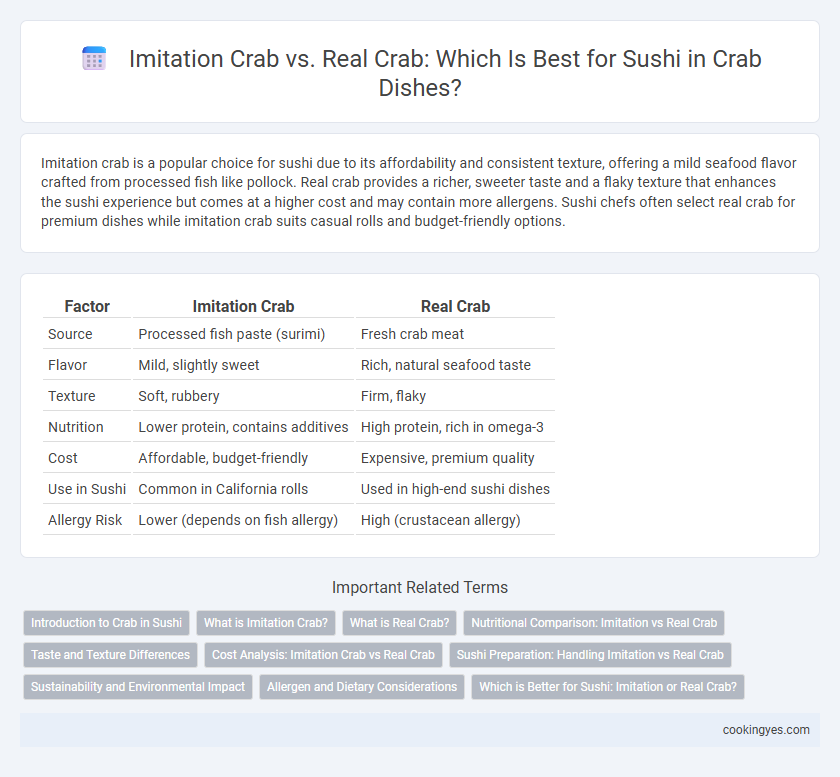Imitation crab is a popular choice for sushi due to its affordability and consistent texture, offering a mild seafood flavor crafted from processed fish like pollock. Real crab provides a richer, sweeter taste and a flaky texture that enhances the sushi experience but comes at a higher cost and may contain more allergens. Sushi chefs often select real crab for premium dishes while imitation crab suits casual rolls and budget-friendly options.
Table of Comparison
| Factor | Imitation Crab | Real Crab |
|---|---|---|
| Source | Processed fish paste (surimi) | Fresh crab meat |
| Flavor | Mild, slightly sweet | Rich, natural seafood taste |
| Texture | Soft, rubbery | Firm, flaky |
| Nutrition | Lower protein, contains additives | High protein, rich in omega-3 |
| Cost | Affordable, budget-friendly | Expensive, premium quality |
| Use in Sushi | Common in California rolls | Used in high-end sushi dishes |
| Allergy Risk | Lower (depends on fish allergy) | High (crustacean allergy) |
Introduction to Crab in Sushi
Real crab offers a naturally sweet, delicate flavor and a firm texture that enhances the authentic taste of sushi. Imitation crab, often made from processed white fish like pollock, provides a budget-friendly alternative with a milder taste and softer, uniform texture. Sushi chefs choose between real and imitation crab based on flavor preferences, cost considerations, and availability, impacting the overall sushi experience.
What is Imitation Crab?
Imitation crab, also known as surimi, is a seafood product made from finely pulverized white fish, typically Alaskan pollock, mixed with starch, sugar, and flavorings to replicate the texture and taste of real crab meat. It is widely used in sushi rolls such as California rolls due to its affordability, consistent flavor, and ease of use compared to real crab, which has a firmer texture and richer flavor but is more expensive. Nutritionally, imitation crab is lower in protein and may contain additives, making it a popular yet less authentic alternative to real crab in sushi preparation.
What is Real Crab?
Real crab used in sushi comes from various species like snow crab, king crab, and blue crab, prized for their sweet, delicate flavor and tender texture. Unlike imitation crab, which is made from processed fish paste known as surimi, real crab provides a natural seafood experience rich in protein and essential nutrients. Its distinct taste and flaky consistency make it a preferred choice for authentic sushi dishes.
Nutritional Comparison: Imitation vs Real Crab
Imitation crab, made primarily from processed white fish such as pollock, contains lower levels of protein and omega-3 fatty acids compared to real crab, which is rich in these nutrients essential for heart health. Real crab also provides higher amounts of vitamins B12 and zinc, supporting immune function and energy metabolism. While imitation crab offers a budget-friendly alternative with fewer calories and fat, it lacks the nutritional density found in genuine crab meat used in sushi.
Taste and Texture Differences
Imitation crab, made from processed fish paste called surimi, offers a mild, slightly sweet flavor and a firm yet rubbery texture, lacking the rich, briny taste of real crab meat. Real crab, especially varieties like snow crab or king crab, provides a delicate sweetness and tender, flaky texture that enhances the sushi experience with authentic oceanic depth. The subtle contrast in taste and texture between imitation and real crab significantly influences the overall quality and enjoyment of sushi dishes.
Cost Analysis: Imitation Crab vs Real Crab
Imitation crab is significantly cheaper than real crab, making it a cost-effective choice for sushi restaurants seeking to manage expenses. Real crab prices fluctuate based on season and sourcing, often doubling or tripling the cost compared to imitation crab, which is primarily made from processed white fish like pollock. The lower price of imitation crab allows for larger portion servings and menu variety without drastically impacting profit margins.
Sushi Preparation: Handling Imitation vs Real Crab
Imitation crab, made from processed white fish and starch, requires less delicate handling during sushi preparation compared to real crab, which demands careful removal of shells and meticulous cleaning to ensure freshness and texture. Real crab's natural flavor and firm texture enhance sushi quality but involve more labor-intensive preparation to maintain its integrity and prevent contamination. Sushi chefs often prefer real crab for premium rolls, reserving imitation crab for budget-friendly options while balancing taste and preparation efficiency.
Sustainability and Environmental Impact
Imitation crab, made primarily from processed fish like pollock, offers a more sustainable option for sushi due to lower reliance on overfished crab populations and reduced environmental strain from crab harvesting. Real crab fisheries often face challenges such as habitat disruption, bycatch, and overexploitation, leading to significant declines in wild crab stocks and negative ecosystem impacts. Choosing imitation crab helps reduce pressure on endangered crab species and supports more sustainable seafood consumption practices.
Allergen and Dietary Considerations
Imitation crab often contains fish-based ingredients like pollock and additives that may trigger allergies in individuals sensitive to seafood or gluten, while real crab is a natural crustacean allergen that can cause severe reactions in shellfish-sensitive consumers. For dietary considerations, real crab provides higher protein and essential nutrients such as omega-3 fatty acids, whereas imitation crab typically has lower protein content and may include added sugars and starches. Choosing between imitation and real crab for sushi depends on specific allergen risks and nutritional goals.
Which is Better for Sushi: Imitation or Real Crab?
Real crab offers a rich, natural flavor and flaky texture that enhances the authenticity of sushi, making it a preferred choice for traditional sushi enthusiasts. Imitation crab, made from processed fish like pollock, provides a cost-effective and consistent alternative with a milder taste and firmer texture, suitable for affordable or mass-produced sushi varieties. Nutritionally, real crab contains higher protein and essential minerals, while imitation crab is often lower in calories and fat, impacting both flavor and health considerations in sushi selection.
Imitation crab vs Real crab for sushi Infographic

 cookingyes.com
cookingyes.com